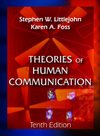
Theories of Human Communication

After retention occurs, organization members face a choice point. They mustdecide first whether to look again at the environment in a new way—to return toissues they chose not to focus on as they proceeded through the enactment-selection-retention process. Here, they address the question, “Should we (or I) attend tosome aspect of the environment th
... See moreKaren A. Foss • Theories of Human Communication
The second requirement for coherence in thefield is a definition of theory. Rather than viewing a theory as an explanation of aprocess, it should be seen as a statement or argument in favor of a particularapproach. In other words, theories are a form of discourse.
Karen A. Foss • Theories of Human Communication
rhetorical work can serve as equipment for living in avariety of ways. It can provide a vocabulary of thoughts, actions, emotions, andattitudes for understanding and interpreting a situation.
Karen A. Foss • Theories of Human Communication
If you can find a useful metamodel, you will be able to make connectionsamong theories, and if you see communication theory as metadiscourse, you willbegin to understand the value of multiple perspectives in the field.
Karen A. Foss • Theories of Human Communication
“Communication Theory as a Field,” Robert T. Craig
Karen A. Foss • Theories of Human Communication
Frank Dance found three points of “critical conceptual differentiation” inattempts to define communication.
Karen A. Foss • Theories of Human Communication
intentionality.
Karen A. Foss • Theories of Human Communication
If the aim of science is to reducehuman differences in what is observed, the aim of the humanities is to understandindividual subjective responses.
Karen A. Foss • Theories of Human Communication
The first stage is asking questions.